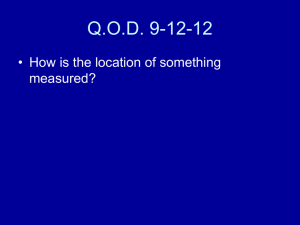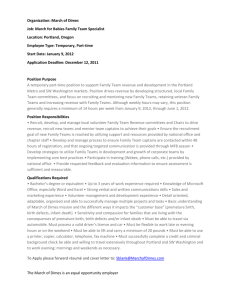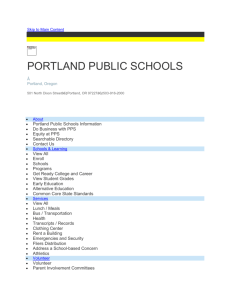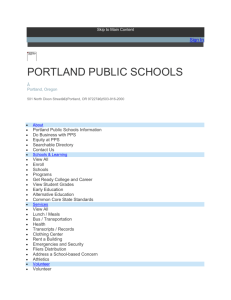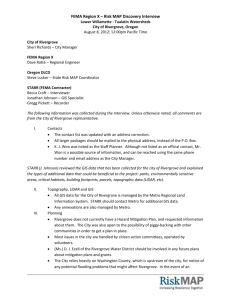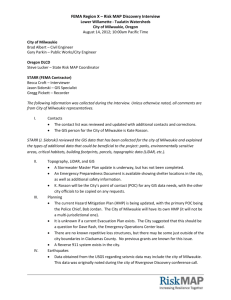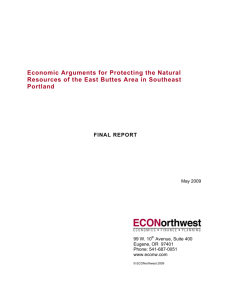FOR FEMA AND STATE REVIEW-MeetingMinutes
advertisement
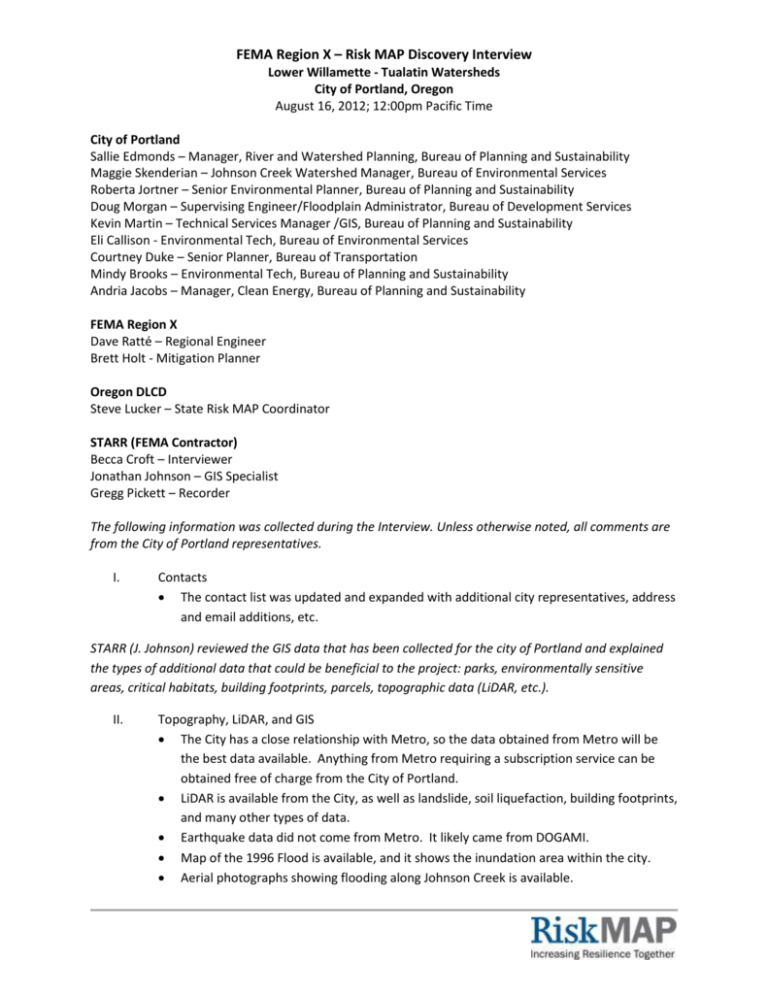
FEMA Region X – Risk MAP Discovery Interview Lower Willamette - Tualatin Watersheds City of Portland, Oregon August 16, 2012; 12:00pm Pacific Time City of Portland Sallie Edmonds – Manager, River and Watershed Planning, Bureau of Planning and Sustainability Maggie Skenderian – Johnson Creek Watershed Manager, Bureau of Environmental Services Roberta Jortner – Senior Environmental Planner, Bureau of Planning and Sustainability Doug Morgan – Supervising Engineer/Floodplain Administrator, Bureau of Development Services Kevin Martin – Technical Services Manager /GIS, Bureau of Planning and Sustainability Eli Callison - Environmental Tech, Bureau of Environmental Services Courtney Duke – Senior Planner, Bureau of Transportation Mindy Brooks – Environmental Tech, Bureau of Planning and Sustainability Andria Jacobs – Manager, Clean Energy, Bureau of Planning and Sustainability FEMA Region X Dave Ratté – Regional Engineer Brett Holt - Mitigation Planner Oregon DLCD Steve Lucker – State Risk MAP Coordinator STARR (FEMA Contractor) Becca Croft – Interviewer Jonathan Johnson – GIS Specialist Gregg Pickett – Recorder The following information was collected during the Interview. Unless otherwise noted, all comments are from the City of Portland representatives. I. Contacts The contact list was updated and expanded with additional city representatives, address and email additions, etc. STARR (J. Johnson) reviewed the GIS data that has been collected for the city of Portland and explained the types of additional data that could be beneficial to the project: parks, environmentally sensitive areas, critical habitats, building footprints, parcels, topographic data (LiDAR, etc.). II. Topography, LiDAR, and GIS The City has a close relationship with Metro, so the data obtained from Metro will be the best data available. Anything from Metro requiring a subscription service can be obtained free of charge from the City of Portland. LiDAR is available from the City, as well as landslide, soil liquefaction, building footprints, and many other types of data. Earthquake data did not come from Metro. It likely came from DOGAMI. Map of the 1996 Flood is available, and it shows the inundation area within the city. Aerial photographs showing flooding along Johnson Creek is available. Risk MAP Discovery Interview – Lower Willamette - Tualatin Watersheds City of Portland – August 16, 2012 III. IV. V. VI. Page 2 of 4 Flood depth data is available for some areas, including Johnson Creek. A CLOMR is underway on Johnson Creek, and this was annotated on the display map. Stream restoration work is also underway in the same area, with will allow some additional flood storage capability. Planning The City has a Hazard Mitigation Plan (HMP) that was adopted in 2010. The plan includes 8 or 9 different hazard areas. It was unknown if any data layers are directly associated with the plan. The City believes there is text, but no map, associated with the plan. The HMP lists specific projects, and prioritizes them. Previous mitigation grants include fire-related mitigation in natural areas, evasive plant removal, controlled burns, pre-disaster grants, etc. Land was bought in 1996 with FEMA money. This was post-disaster money to purchase property to be turned into open space. The city has purchased 80 acres and another 100 acres of floodplain restoration is underway. Four locations total are planned (funded and proposed) along Johnson Creek. Seismic retrofits of a number of buildings are underway and planned. Energy-related retrofits are also being considered. The City’s Energy Assurance Plan is currently being evaluated that could help reduce future power outages and damage to critical facilities. The City’s Comprehensive Plan is being updated. New growth scenarios for the next 20 years are being considered. The Portland Watershed Management Plan is taken into consideration in the City’s Hazard Mitigation Plan. Earthquakes The city has experienced many earthquakes in the past, including a 5.6 magnitude in 1993 that caused slight damage, including cosmetic damage to buildings. Upgrades to some buildings have been required because they are/were insufficiently constructed for the potential earthquakes of the area. Earthquake fault information has been obtained, and 7.0+ magnitude earthquakes are a possibility. Wildfires A wildfire hazard zone has been established that is very broad; maps can be provided by the City. Some critical structures a risk for wildfire damage have been identified on the maps. A Wildfire protection plan has been compiled for Portland and the area fire districts. Severe Storms Snow and ice storms are the most likely cause of storm damage in the city of Portland, along with tree damage causing power outages, occasional road closures, icing, etc. Risk MAP Discovery Interview – Lower Willamette - Tualatin Watersheds City of Portland – August 16, 2012 VII. VIII. Page 3 of 4 Shelter information was not known, however cooling and heating centers have been used in the past. Twitter is used for emergency alerts, as well as the local media, text flashes, phone calls, etc. Flooding Specific areas regarding flooding will be identified and discussed at the Discovery meeting. Johnson Creek is the most notorious and some areas outside of the SFHA were flooded during the recent 20 to 28 year event. The City was not sure if the ongoing CLOMR addresses this issue or not. Johnson Creek Restoration Plan is about 65% completed (4 areas were annotated on the map). Stormwater and groundwater flooding does occur. Multnomah County Drainage District would be a good group to contact for flooding information, LOMRs, etc. Sub-watershed analysis is underway in the Johnson Creek Watershed. The Columbia Slough will be studied in the near future and the Willamette River has been studied previously in this way. These studies look very closely how stormwater is handled in the sub-drainage areas. Communications and Outreach CRS requires them to send annual information for SFHA residents. Utility bills come with information about flooding and other emergencies. Road detour and sandbag locations are given to residents. Local committees are formed for planning, and discussions of risk would occur at those meetings. Neighborhood groups are formed to respond to emergencies. Information regarding retrofitting, wildfire risk, native plants, fire resistant plants, etc. can be found on the City website. The website http://www.portlandmaps.com/ also has information regarding emergency preparedness. Transition Portland, a local organization, includes neighborhood resiliency workshops. The City was not sure whether the group is directly affiliated with the City of Portland. Multnomah Drainage District does a ton of outreach. There are also local watershed councils and the City’s Office of Neighborhood Involvement. The West Hills area has neighborhood meetings, especially regarding landslide hazards. The Floodplain Administrator is D. Morgan. The City does not have a separate floodplain development permit. They enforce the NFIP regulations and the local ordinance and regulate development in the floodplain through the building permit process. The City expressed some need for templates, training, webinars, attending conferences, etc. Risk MAP Discovery Interview – Lower Willamette - Tualatin Watersheds City of Portland – August 16, 2012 IX. Page 4 of 4 ESA training is needed. The City has previously participated in some training and webinars online and is aware of the STARR Region X newsletter. Portland would like to do informational workshops and training for realtors, mortgage brokers, title companies, insurance agents, low-income residents, non-English-speaking residents, etc., regarding the purchase of a home in or near the floodplain. Funding would be needed to do this work. The City expressed an interest in trying to obtain a small grant to do this work. The State is working with the Climate Change Center and wants to talk to the City more about this. Other The City noted that the FEMA on-line training and webinars were “great”, and that they were very easy to attend. Community said it was “great news” that this effort was underway to help them. The City is an active participant in the Community Rating System (Class 5). A few new bridges including a new light rail bridge are being constructed in the watershed. Riverbank modification has taken place in recent years along the Willamette River that has probably not been considered on the newest FIRMs. Annexation is being considered for industrial use, including 300 acres currently located in the floodplain. D. Ratté expressed interest in knowing more about the city’s surface water management practices at the upcoming Discovery meetings.
